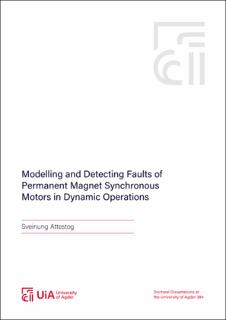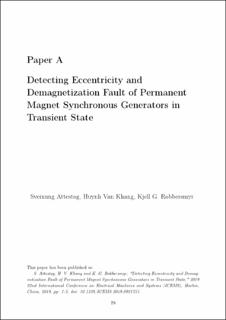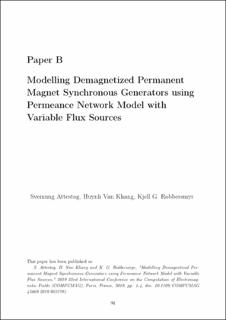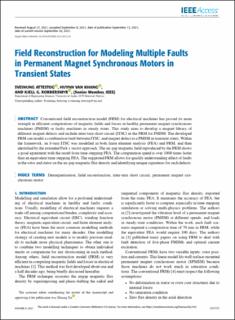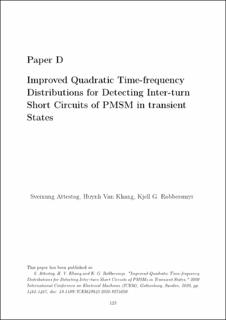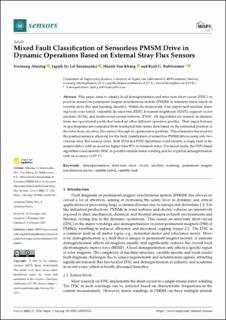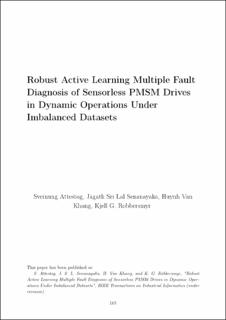| dc.contributor.author | Attestog, Sveinung | |
| dc.contributor.editor | Robbersmyr, Kjell Gunnar | |
| dc.contributor.editor | Van Khang, Huynh | |
| dc.date.accessioned | 2022-10-12T12:57:39Z | |
| dc.date.available | 2022-10-12T12:57:39Z | |
| dc.date.created | 2022-10-04T12:35:00Z | |
| dc.date.issued | 2022 | |
| dc.identifier.citation | Attestog, S. (2022). Modelling and Detecting Faults of Permanent Magnet Synchronous Motors in Dynamic Operations [PhD. thesis]. University of Agder. | en_US |
| dc.identifier.isbn | 978-82-8427-095-1 | |
| dc.identifier.issn | 1504-9272 | |
| dc.identifier.uri | https://hdl.handle.net/11250/3025635 | |
| dc.description.abstract | Permanent magnet synchronous motors (PMSMs) have played a key role in commercial and industrial applications, i.e. electric vehicles and wind turbines. They are popular due to their high efficiency, control simplification and large torque-to-size ratio although they are expensive. A fault will eventually occur in an operating PMSM, either by improper maintenance or wear from thermal and mechanical stresses. The most frequent PMSM faults are bearing faults, short-circuit and eccentricity. PMSM may also suffer from demagnetisation, which is unique in permanent magnet machines. Condition monitoring or fault diagnosis schemes are necessary for detecting and identifying these faults early in their incipient state, e.g. partial demagnetisation and inter-turn short circuit. Successful fault classification will ensure safe operations, speed up the maintenance process and decrease unexpected downtime and cost. The research in recent years is drawn towards fault analysis under dynamic operating conditions, i.e. variable load and speed. Most of these techniques have focused on the use of voltage, current and torque, while magnetic flux density in the air-gap or the proximity of the motor has not yet been fully capitalised.
This dissertation focuses on two main research topics in modelling and diagnosis of faulty PMSM in dynamic operations. The first problem is to decrease the computational burden of modelling and analysis techniques. The first contributions are new and faster methods for computing the permeance network model and quadratic time-frequency distributions. Reducing their computational burden makes them more attractive in analysis or fault diagnosis. The second contribution is to expand the model description of a simpler model. This can be achieved through a field reconstruction model with a magnet library and a description of both magnet defects and inter-turn short circuits.
The second research topic is to simplify the installation and complexity of fault diagnosis schemes in PMSM. The aim is to reduce required sensors of fault diagnosis schemes, regardless of operation profiles. Conventional methods often rely on either steady-state or predefined operation profiles, e.g. start-up. A fault diagnosis scheme robust to any speed changes is desirable since a fault can be detected regardless of operations. The final contribution is the implementation of reinforcement learning in an active learning scheme to address the imbalance dataset problem. Samples from a faulty PMSM are often initially unavailable and expensive to acquire. Reinforcement learning with a weighted reward function might balance the dataset to enhance the trained fault classifier’s performance. | en_US |
| dc.language.iso | eng | en_US |
| dc.publisher | University of Agder | en_US |
| dc.relation.ispartofseries | Doctoral Dissertations at the University of Agder; no. 384 | |
| dc.relation.haspart | Paper I: Attestog, S., Huynh, K. & Robbersmyr, K. G. (2019). Detecting Eccentricity and Demagnetization Fault of Permanent Magnet Synchronous Generators in Transient State. In 22nd International Conference on Electrical Machines and Systems. IEEE. https://doi.org/10.1109/ICEMS.2019.8921753. Accepted version. Full-text is available in AURA as a separate file: . | en_US |
| dc.relation.haspart | Paper II: Attestog, S., Huynh, K. & Robbersmyr, K. G. (2019). Modelling Demagnetized Permanent Magnet Synchronous Generators using Permeance Network Model with Variable Flux Sources. In 2019 22nd International Conference on the Computation of Electromagnetic Fields. IEEE. https://doi.org/10.1109/COMPUMAG45669.2019.9032791. Accepted version. Full-text is available in AURA as a separate file: . | en_US |
| dc.relation.haspart | Paper III: Attestog, S., Van Khang, H. & Robbersmyr, K. G. (2021). Field Reconstruction for Modeling Multiple Faults in Permanent Magnet Synchronous Motors in Transient States. IEEE Access, 9, 127131-127140. https://doi.org/10.1109/ACCESS.2021.3112224. Accepted version. Full-text is available in AURA as a separate file: https://hdl.handle.net/11250/2990560. | en_US |
| dc.relation.haspart | Paper IV: Attestog, S., Van Khang, H. & Robbersmyr, K. G. (2020). Improved Quadratic Time-frequency Distributions for Detecting Inter-turn Short Circuits of PMSMs in Transient States. In 2020 International Conference on Electrical Machines (p. 1461-1467). IEEE. https://doi.org/10.1109/ICEM49940.2020.9271050. Accepted version. Full-text is available in AURA as a separate file: . | en_US |
| dc.relation.haspart | Paper V: Attestog, S., Senanayaka, J. S. L., Van Khang, H. & Robbersmyr, K. G. (2022). Mixed Fault Classification of Sensorless PMSM Drive in Dynamic Operations Based on External Stray Flux Sensors. Sensors, 22(3), 19. https://doi.org/10.3390/s22031216. Accepted version. Full-text is available in AURA as a separate file: https://hdl.handle.net/11250/3013101. | en_US |
| dc.relation.haspart | Paper VI: Attestog, S., Senanayaka, J. S. L., Van Khang, H. & Robbersmyr, K. G. (2022). Robust Active Learning Multiple Fault Diagnosis of PMSM Drives with Sensorless Control under Dynamic Operations and Imbalanced Datasets. IEEE Transactions on Industrial Informatics. https://doi.org/10.1109/TII.2022.3227628. Accepted version. Full-text is available in AURA as a separate file: . | en_US |
| dc.rights | Attribution-NonCommercial-NoDerivatives 4.0 Internasjonal | * |
| dc.rights.uri | http://creativecommons.org/licenses/by-nc-nd/4.0/deed.no | * |
| dc.title | Modelling and Detecting Faults of Permanent Magnet Synchronous Motors in Dynamic Operations | en_US |
| dc.type | Doctoral thesis | en_US |
| dc.description.version | publishedVersion | en_US |
| dc.rights.holder | © 2022 Sveinung Attestog | en_US |
| dc.subject.nsi | VDP::Teknologi: 500::Maskinfag: 570 | en_US |
| dc.source.pagenumber | 218 | en_US |
| dc.source.issue | 384 | en_US |
| dc.identifier.cristin | 2058347 | |
